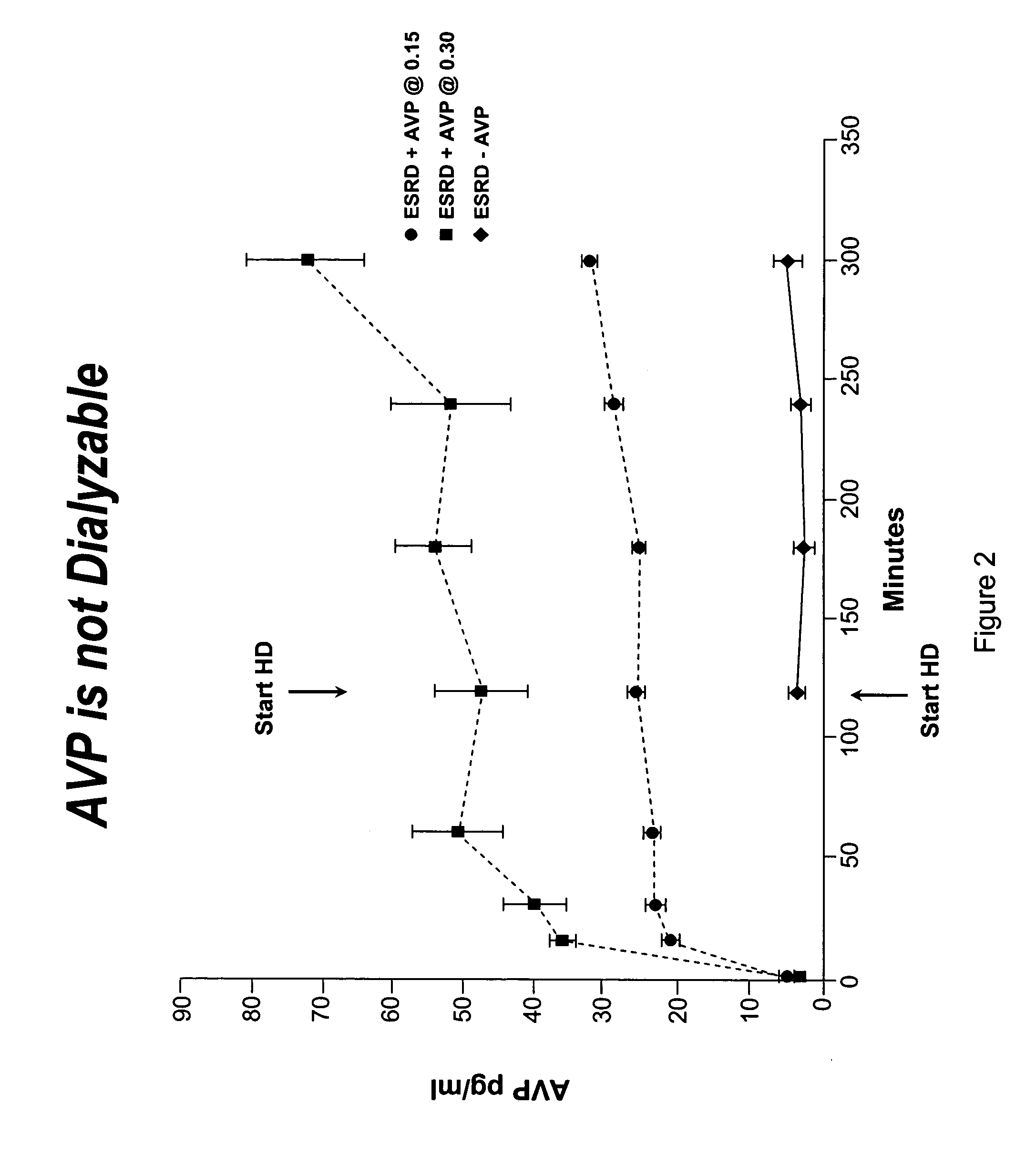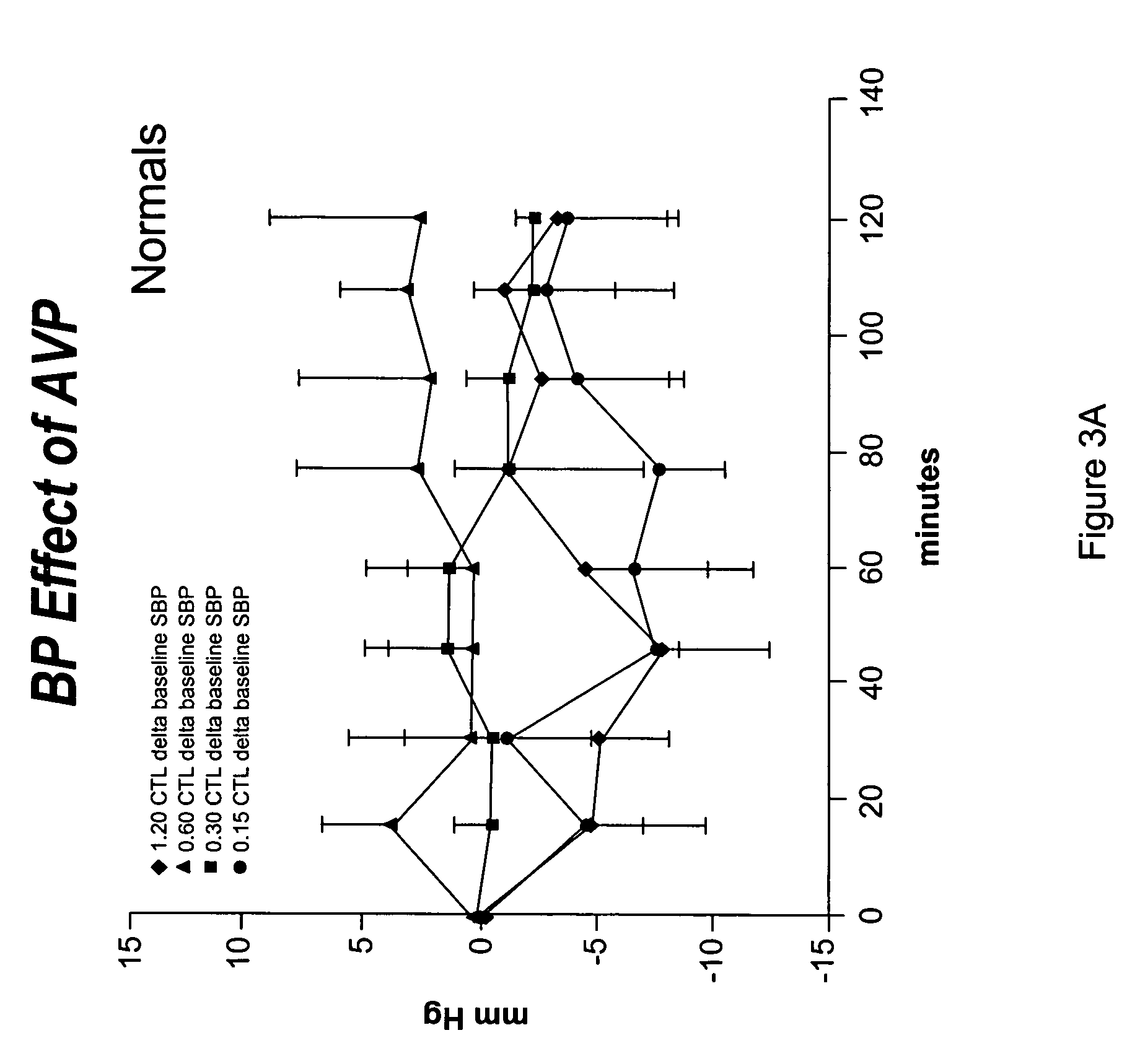Method for stabilizing blood pressure in hemodialysis subjects
a hemodialysis and blood pressure technology, applied in the direction of peptides, drug compositions, peptides, etc., can solve the problems of reducing the efficiency of fluid removal during treatment, affecting the effect of hemodialysis, and avoiding the abandonment of one of the principal objectives of hemodialysis, so as to reduce excess extracellular fluid, maintain blood pressure, and facilitate the effect of reducing excess extracellular fluid
- Summary
- Abstract
- Description
- Claims
- Application Information
AI Technical Summary
Benefits of technology
Problems solved by technology
Method used
Image
Examples
example 1
[0050]This Example describes the procedure to utilize vasopressin to stabilize blood pressure during hemodialysis and facilitate removal of excess extracellular fluid.
Description of Study Procedures
[0051]Healthy controls and patients with end-stage renal disease (e.g. defined as creatinine clearance of less than 10 ml / min) were studied. The studies were conducted on regularly scheduled hemodialysis days. The duration of hemodialysis remained the same as that prescribed prior to the study period. AVP or placebo (normal saline) was administered at a constant rate of 0.15, 0.3 or o.6 mU / kg / min through a venous line (controls) or through the venous limb of the dialysis circuit (hemodialysis patients). The patient's hemodialysis prescription remained unchanged except for the administration of AVP or placebo. Intradialytic hypotension was treated in the customary manner with the infusion of isotonic and hypertonic fluids.
[0052]Serum AVP levels were determined by a radioimmunoassay techniq...
example 2
[0087]This Example describes a procedure to test that long term administration of vasopressin during hemodialysis results in an improvement of patient's hypertension.
Experimental Methods and Design
Data Collection
[0088]This is a randomized, double-blinded, placebo-controlled trial to determine the effect of AVP administration during dialysis on blood pressure.
[0089]Eligible patients are stratified for purposes of randomization into high blood pressure (systolic blood pressure or SBP 140-170) and very high blood pressure (SBP >170) groups, as well as diabetic and non-diabetic groups.
[0090]Patients are randomized to receive normal saline with AVP (treatment) or normal saline alone (placebo) during dialysis. A randomization protocol is used to determine whether the drug or placebo is to be administered. The identity of the substance being administered remains unknown to both the clinical staff and the patient. To insure that the nursing personnel does not become biased toward a particul...
example 3
Methods
[0100]Patients. Studies were performed at the Acute Dialysis Unit of the New York Presbyterian Hospital and at the Columbia University Dialysis Center, both located at Columbia Presbyterian Medical Center. All patients gave informed consent to participate in the study, which was approved by the Institutional Review Board of Columbia University.
[0101]All patients were studied at regularly scheduled dialysis sessions. Patients underwent conventional hemodialysis with hollow fiber high flux polysulfone dialyzers on volumetric dialysis machines (Cobe Centrysystem 3, Gambro Renal Care Products, Inc., Lakewood, Colo.). Dialysis times were 3.5–4.5 hours. Blood flow was 300–400 mL / min and dialysate was delivered at 600 mL / min. The dialysis bath contained potassium, 2 mEq / L; calcium, 2.5 mEq / L; magnesium, 0.75 mEq / L; and bicarbonate, 40 mEq / L. In those patients who were prescribed dialysate sodium modeling and / or reduced dialysate temperature (35–37° C.) prior to the study, the parame...
PUM
| Property | Measurement | Unit |
|---|---|---|
| blood pressure | aaaaa | aaaaa |
| blood pressure | aaaaa | aaaaa |
| systolic blood pressure | aaaaa | aaaaa |
Abstract
Description
Claims
Application Information
 Login to View More
Login to View More - R&D
- Intellectual Property
- Life Sciences
- Materials
- Tech Scout
- Unparalleled Data Quality
- Higher Quality Content
- 60% Fewer Hallucinations
Browse by: Latest US Patents, China's latest patents, Technical Efficacy Thesaurus, Application Domain, Technology Topic, Popular Technical Reports.
© 2025 PatSnap. All rights reserved.Legal|Privacy policy|Modern Slavery Act Transparency Statement|Sitemap|About US| Contact US: help@patsnap.com



